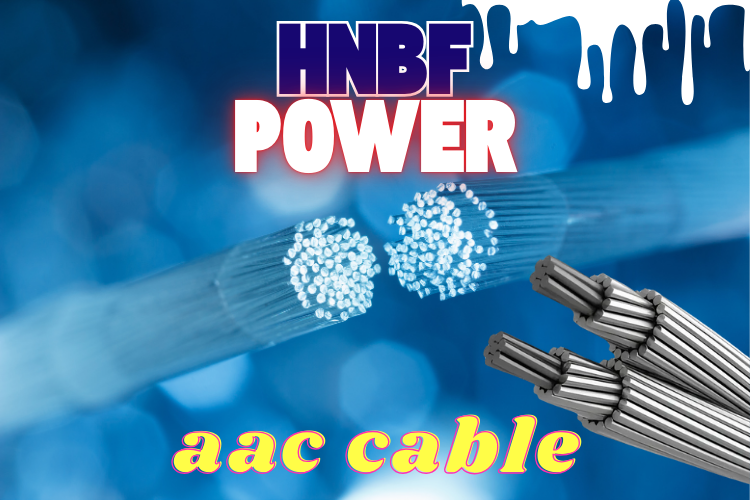When it comes to overhead power distribution, AAC cables (All Aluminum Conductor cables) remain a preferred choice for engineers, utilities, and procurement specialists. Designed to provide high conductivity with low weight, AAC cables are widely used in urban, rural, and industrial power networks. HNBF Power, a global leader in manufacturing overhead conductors and power cables, delivers premium-quality AAC cables engineered to meet stringent international standards and ensure long-term reliability.
What is AAC Cable?
AAC cable stands for All Aluminum Conductor cable, composed entirely of high-purity aluminum strands. Unlike ACSR (Aluminum Conductor Steel Reinforced) cables that incorporate a steel core for added strength, AAC cables are lightweight and purely conductive, making them ideal for short to medium-span power transmission lines where mechanical load is moderate.
Key characteristics include:
- High electrical conductivity
- Lightweight design for easy installation
- Corrosion resistance in urban and industrial environments
- Compliance with international standards like IEC and ASTM
These features make AAC cables suitable for overhead power distribution across residential, commercial, and industrial sectors.
Applications of AAC Cable
AAC cables are versatile and used in multiple overhead power transmission scenarios:
- Urban and Rural Distribution – Perfect for low-voltage and medium-voltage lines in residential neighborhoods and towns.
- Industrial Sites – Efficient for supplying power to industrial complexes and manufacturing units.
- Temporary Power Networks – Reliable for construction sites or temporary setups due to lightweight installation.
- Secondary Transmission Lines – Ideal for connecting substations and local distribution networks.
At HNBF Power, our AAC cables are designed for performance, durability, and ease of installation, catering to the specific needs of engineers and procurement teams.
Advantages of Choosing AAC Cable from HNBF Power
Selecting the right AAC cable ensures efficiency, safety, and longevity. Some benefits of HNBF Power AAC cables include:
- Superior Conductivity: High-quality aluminum strands provide low resistance and minimal power loss.
- Lightweight Construction: Easy handling and installation, reducing labor costs and installation time.
- Corrosion Resistance: Excellent durability against atmospheric corrosion, ensuring long-term service life.
- Custom Solutions: Tailored specifications for voltage ratings, strand sizes, and lengths to match your project requirements.
By using AAC cables from HNBF Power, engineers can achieve reliable power distribution while maintaining operational efficiency and safety.
AAC Cable Manufacturing Process
Understanding the manufacturing process of AAC cables helps ensure product reliability:
- Aluminum Wire Drawing – High-purity aluminum rods are drawn into strands of precise diameter.
- Stranding – Individual strands are twisted into a single conductor with uniform cross-section and mechanical strength.
- Annealing – Conductors are heat-treated to improve flexibility and conductivity.
- Quality Testing – Electrical, mechanical, and dimensional tests ensure compliance with industry standards.
HNBF Power strictly follows global quality protocols to produce AAC cables with consistent performance for diverse applications.
Choosing the Right AAC Cable
When selecting AAC cables, engineers and buyers should consider:
- Voltage Rating: Ensure the cable matches the system’s operational voltage.
- Conductor Size: Choose based on current-carrying capacity and line length.
- Installation Environment: Consider urban, rural, or industrial conditions for corrosion resistance.
- Standards Compliance: Verify adherence to international standards for safety and performance.
HNBF Power offers expert guidance to help clients choose the most suitable AAC cable configuration for their projects.
FAQs About AAC Cable
Q1: What is the difference between AAC and ACSR cables?
A: AAC is fully aluminum and lightweight, suitable for short to medium spans. ACSR has a steel core for added strength, ideal for long-span transmission lines.
Q2: Can AAC cables be used in coastal areas?
A: Yes, AAC cables from HNBF Power are corrosion-resistant, making them suitable for coastal and industrial environments.
Q3: What voltage levels are AAC cables suitable for?
A: AAC cables are generally used for low to medium voltage overhead distribution lines.
Q4: How do I determine the right AAC cable size for my project?
A: The choice depends on current-carrying requirements, line length, and environmental factors. HNBF Power offers technical support for precise selection.
Q5: Are custom lengths and sizes available?
A: Yes, HNBF Power provides AAC cables tailored to your project’s specific requirements.
Conclusion
AAC cables are an essential component in modern overhead power distribution networks. With high conductivity, lightweight design, and corrosion resistance, they offer reliable performance for various applications. HNBF Power, a global manufacturer of overhead conductors and power cables, delivers premium AAC cables engineered to meet the highest standards.
Contact HNBF Power today to explore customized AAC cable solutions that perfectly fit your project needs and ensure uninterrupted, efficient power distribution.



